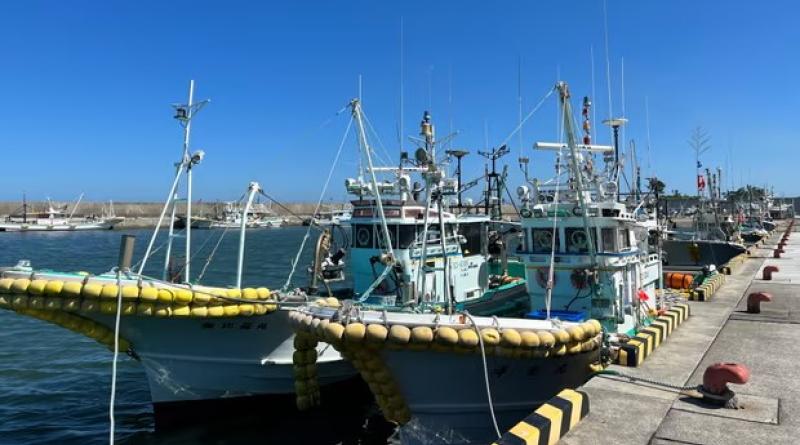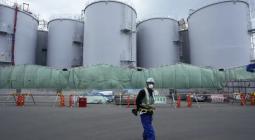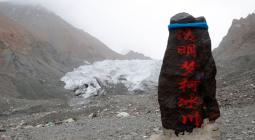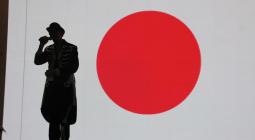‘They won’t buy it’: fish traders anxious after Fukushima wastewater release

The release of water from the Japanese nuclear plant has already caused the price of produce from surrounding coastal areas to drop.
Awa-jinja is a place of pilgrimage for the more superstitious fishers of Shinchi-machi, a coastal town in Fukushima, who come here to lower their heads and ask the Shinto gods to look kindly on them as they prepare to steer their boats into the vast Pacific Ocean.
Today, though, the “safe waves” implicit in the shrine’s name are of little concern to the men and women coming to the end of the working day at the town’s fishing port.
“That has only just started, and prices were already down at auction this morning,” says Haruko, a fish trader, as she sits in the shade with a carton of fruit juice while other workers hose down the concrete forecourt.
“That,” she indicates with the wave of a hand in the direction of the sea, is the start of the most controversial stage in the long, and fraught, task of decommissioning the Fukushima Daiichi nuclear power plant after it was struck by a powerful earthquake and tsunami in March 2011, which caused three of its reactors to go into meltdown.
In images broadcast live online on Thursday, engineers behind computer screens opened valves to allow the first batch of 1.3m tonnes of wastewater from the plant to flow into the sea.
“Our family eats seafood from Fukushima all the time, but now I hear people say that they won’t buy it,” says Haruko, a mother of three who declined to give her family name. “They certainly don’t want to give it to their children. And if people stop buying fish from Fukushima, I’m out of a job.”
China’s decision to ban all Japanese seafood in response to the discharge added to fears among people in coastal communities near the stricken plant that pumping “contaminated” water into the sea will sound the death knell for the local fishing industry.
“The fishing communities of Japan are feeling increasingly anxious as they witness this moment” despite government assurances, the head of the country’s fisheries co-operative said in a statement.
The plant’s operator, Tokyo Electric Power (Tepco), uses on-site filtration to reduce amounts of more than 60 radionuclides to government-set releasable levels. But the technology is unable to do the same to tritium, a radioactive isotope of hydrogen that Japanese officials backed by the International Atomic Energy Agency, and many scientists, insist has no detrimental effect on human health in low doses.
Haruo Ono, 71, who has fished off the Fukushima coast since he was 15, says government assurances will do nothing to protect him and other fishers from harmful rumours over the safety of their catch.
He says fishing cooperatives across Fukushima are united in the belief that pumping the water – enough to fill of 540 Olympic swimming pools – into the ocean will undermine more than a decade of work to revive their industry.
“We were 100% opposed the water release, we still oppose it, and we will continue to oppose it,” says Ono, whose brother died in the triple disaster. “The government hasn’t listened to fishing communities in deciding how to deal with the water. It has abandoned the people of Fukushima to protect Tepco.”
While many in Fukushima accept the science behind the decision to discharge diluted wastewater into the sea over the next 30 to 40 years, they believe Japan’s government has failed to convince consumers that their catch is safe.
The government has allocated ¥80bn ($550m) to support fisheries and seafood processing and address potential reputational damage. But Ono, who will fish for flounder, mackerel and whitebait next week, said he would rather work without fear than depend on financial support.
“That’s my job,” he says. “The sea is our workplace … it’s where we go to make a living.”
Tepco’s announcement that it had begun releasing the water did not deter anglers dotted along a jetty south of the port.
“I come here three times a week, and I plan to keep coming,” said one, referring to himself as Morimoto. “I eat migratory fish I catch, but I’m cautious about bottom feeders,” he said, nodding in the direction of Fukushima Daiichi, 30 miles to the south. “I fish for fun, but I feel sorry for people who depend on it for their livelihoods.”
On nearby Odohama beach, Takayuki Endo is braving the fierce early afternoon sunshine, casting his lines into the Pacific in the hope of catching a flounder to take home for dinner.

“They only just started releasing the water today, so perhaps my fish won’t be affected yet,” he jokes.
“I accept the scientific explanations about why the tritium doesn’t pose a risk, but this is all about natural human reactions,” the 48-year-old adds. “And my gut feeling is that what Tepco and the government are doing isn’t right.”
Even so, he has no intention of removing local seafood from his diet. “If I thought it was going to impact my health in the short-term, then I wouldn’t touch it. But the science says that isn’t going to happen, if at all,” says Endo, who stopped fishing off Fukushima for several years after the nuclear meltdown, only returning to his favourite spot on the beach three years ago.
After the chaos and destruction of the triple disaster – in which more than 18,000 people died, most of them in the tsunami that laid waste to Japan’s north-east coast – fishing cooperatives were beginning to sense that better days were ahead.
“Prices were rising and we were rebuilding our brand,” says Ono, whose three sons followed him into the fishing industry. “We could see a happy ending, but that’s been taken away from us by what happened today. But we will carry on fishing … and fighting.”
Photograph: Justin McCurry/The Guardian - Fishing boats in Shinchi-machi, Fukushima prefecture, where locals are concerned about people’s willingness to eat their catch.





